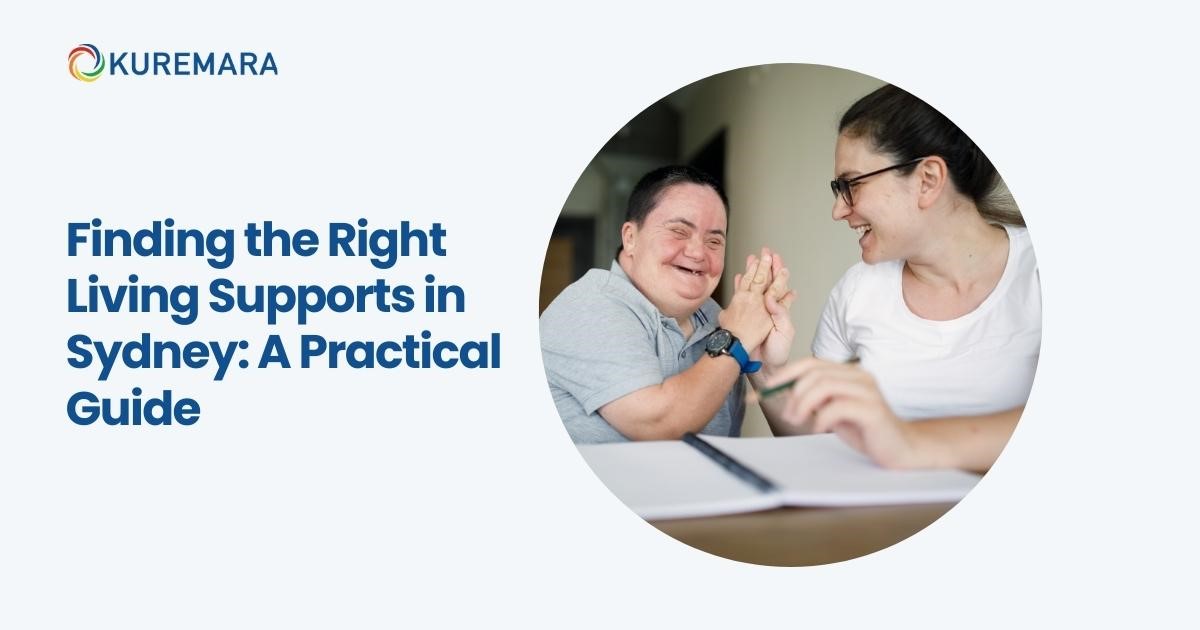For many individuals and families entering the National Disability Insurance Scheme (NDIS), it can be difficult to know which types of living support to choose. Sydney, being one of the biggest cities in Australia, has many options for people living with a disability, who want to live independently, safely and with dignity. Whether it is supported independent living or short-term overnight stays, the options available in Sydney provide both stability and flexibility depending on a person’s needs.
This guide summarises the important terms in relation to living supports in Sydney, outlines available accommodation options, and how participants can make informed decisions when planning their journey to finding the right living supports.
Why Living Supports Matter
The notion of living supports is broader than simply offering a roof over someone’s head. The aim of living supports is to support independence, inclusion and improved quality of life. For people with a disability, an appropriate accommodation option can offer:
- Safety and comfort: A secure environment suited to individual needs.
- Independence: The opportunity for a person to make choices about their daily living.
- Community participation: Freely participated in social circles and opportunities.
- Planned supports suited to individual needs: Professional support, in areas most needed.
With all relevant components in place, participants begin to feel empowered to take charge of their lives and reach the goals contemplated in their NDIS plans.
Understanding Supported Independent Living
Supported Independent Living, also called SIL, is intended for participants who want assistance with daily tasks either in a living arrangement where they have private or fully independent areas of the home, or are residing with others. SIL will cover supports such as personal care, cooking, cleaning and skill development. Supported Independent Living is a more contemporary model of support in that it is focused on teaching and encouraging independence wherever possible, unlike other more traditional care models.
Participants can still feel like they are living with others in a shared home and, in some circumstances, may even be living by themselves while receiving support on a regular basis. Maintaining a lifestyle to closely ALIGN to the normal everyday living experience of the broader community is one of the aims of SIL.
Key Features of Supported Independent Living
- 24/7 support if required: Staff can be on site 24 hours a day in an SIL home, ensuring the safety, wellbeing and more importantly the independence of participants.
- Skill development: Working with staff and/or other participants, skill development is a crucial aspect of SIL. Participants learn how to cook their own meals, budget and save money, and keep their home in a clean and orderly fashion.
- Community connection: SIL homes are typically found in residential suburbs with easy access to public transport, shopping areas, parks and recreation areas.
- Choice and control: Will be supported to make decisions in their lives, which will be about day to day self-management, or planning for the future.
This balance of professional care and personal choice enables people to flourish in supportive yet independent environments.
Short-Term Accommodation
Short-term accommodation (often referred to as respite) provides participants with a temporary housing arrangement. Short-term accommodation may be used when family carers need a break, when transitioning between long-term housing arrangements, or if participants wish to experience different living options before making a permanent decision. Many families explore ndis short term accommodation in Sydney when searching for flexible, temporary options that still provide safety, care, and opportunities for social inclusion.
Short-term stays typically include:
- Furnished accommodation that includes accessible features.
- Meals, and support staff able to assist in daily living activities.
- Social opportunities with other participants or community groups.
Temporary living arrangements are not only useful, but also increases participant independence, confidence and allows them to experience life in new and different ways from their usual home way of living.
Funding and Access through the NDIS
The NDIS have different funding arrangements regarding living supports according to individual plans and assessed needs. Funded support is not “one-size-fits-all” and is generally based on the level of support a participant needs.
For example:
- SIL funding is usually within the Core Supports funding Category.
- Short-term accommodation funding is also possible as long as it aligns to the Participants goals.
Working with support coordinators or plan managers can help participants and their families understand their options and ensure that funding is used effectively.
Choosing the Right Option in Sydney
With so many service providers delivering supports within Sydney, it is important for participants to take their time and consider choices carefully, and to consider some important steps:
1. Consider personal needs and goals: What level of support is needed, what does the participant want to achieve?
2. Investigate available providers: What services are they providing within their local area, is there any feedback from other participants that’s concerns or beneficial?
3. Inspect potential homes: If practical, visit homes to examine if their homes are accessible and comfortable.
4. Ask about the workers qualifications: Quality of care is reliant on trained and experienced support workers.
5. Understand the terms of service: Be clear about the service package with limits provided and how the costs are managed under the NDIS funding.
If participants are able to work through these processes then they can make the best decisions and not be too rushed into an arrangement that is not really going to suit them in the future.
The Significance of Location
Sydney is a large city with a range of suburbs, which offer different environments and lifestyles. Some participants may like to reside in quieter environments that offer health care readily available, while others may wish to be positioned closer to major employment and education opportunities.
When considering accommodation, participants should consider:
- Proximity to public transport.
- Nearby medical centres, hospitals, and allied health providers.
- Nearby shopping centres, community hubs, and parks.
- Nearby cultural and social opportunities which may prove meaningful to the requirements of the participant.
The location of accommodation can play an important role in making sure the participant lives well and feels connected to the wider community.
Building Confidence Through Trial Stays
Participants may trial stays before committing to longer-term arrangements. Trial stays vary in the length of stay, and may give the participant and family a chance to adjust to a new living environment, assess the available level of support, and determine whether this accommodation feels right. Families can feel assured that the accommodation is meeting the expectations of the family and participant.
Trial stays can serve a useful function for a young person wishing to transition to adulthood, as they provide a safe stepping stone towards seeking a greater independence.
Working with Families and Support Coordinators
Families are likely to have an important input in the decision making process and generally, their contribution is of vital importance. Support coordinators also play a vital role in assisting participants to navigate the system, interpret NDIS funding arrangements and communicate with providers.
Working collectively ensures:
- The participant’s voice is always central in the decision making.
- Families are then comfortable with the level of care.
- Coordinators can manage the paperwork and organise the funding.
This collaborative framework will alleviate some of the stress and provide a smoother transition to a new living arrangement for participants.
The Future: Trends in Disability Housing
The disability support industry in Sydney is constantly changing. Providers are increasingly taking a focus on contemporary housing designs that accommodate easy access and promote independence. Technology is also acting as a facilitator towards independence through smart home devices that can assist a person with physical/digitally enabled challenges.
There is also a growing recognition for integrated housing options in community settings so that participants are not segregated into separate facilities. This growth also represents a shift in perspective within society, moving away from hiding disability and now seeing it as an opportunity to celebrate inclusion and diversity.
Conclusion
The thought of negotiating living support in Sydney can feel quite daunting at times, but with a little research and support network behind them, participants and their families can find sustainable solutions that suit their needs and objectives. That’s the important message here: Keeping informed, asking the right questions, and allowing for time to assess all available options, either when looking at long term supported living or short term solutions.
When conducting their research, typically families are finding sil providers Sydney that are offering focused housing with trained staff, as well as options that can provide flexibility when required. Collectively these services form a suite of supports helping to enable individuals the ability to live more independently, achieve increased social participation in the community, and improve their overall quality of life.

